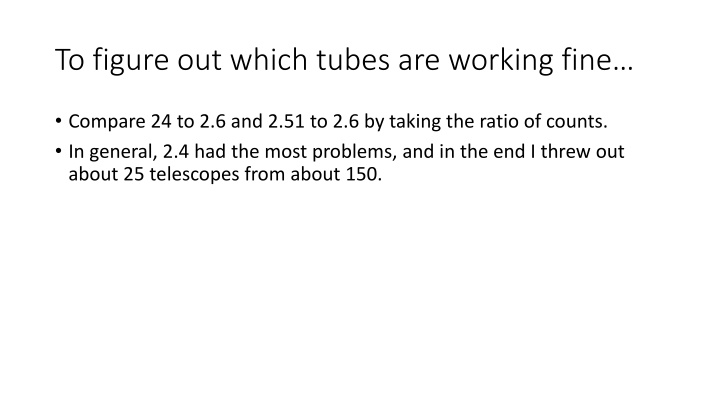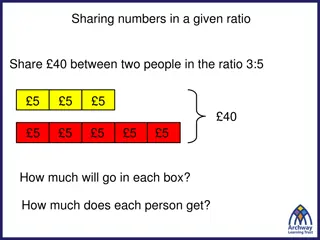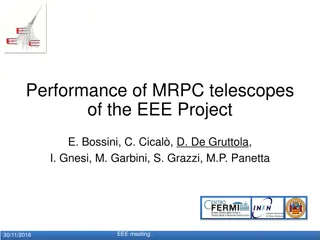Troubleshooting Telescopes Using Ratios and Multiplicities
A detailed process of identifying and resolving issues with telescopes by comparing ratios of counts and utilizing different thresholds. It involves examining ring multiplicities, eliminating problematic channels, and achieving flat, well-aligned results. The method includes optimizing settings and addressing bugs in the code for accurate data analysis and improved performance.
Download Presentation

Please find below an Image/Link to download the presentation.
The content on the website is provided AS IS for your information and personal use only. It may not be sold, licensed, or shared on other websites without obtaining consent from the author.If you encounter any issues during the download, it is possible that the publisher has removed the file from their server.
You are allowed to download the files provided on this website for personal or commercial use, subject to the condition that they are used lawfully. All files are the property of their respective owners.
The content on the website is provided AS IS for your information and personal use only. It may not be sold, licensed, or shared on other websites without obtaining consent from the author.
E N D
Presentation Transcript
To figure out which tubes are working fine Compare 24 to 2.6 and 2.51 to 2.6 by taking the ratio of counts. In general, 2.4 had the most problems, and in the end I threw out about 25 telescopes from about 150.
First I had to decide how to calculate the multiplicity. I generated the same ratio, but for different settings: Eslow>Pedestal+10 channels Eslow>Pedestal+20 channels Eslow>Pedestal+20 channels OR time Time only Basically, once I fixed the thresholds that I was using (the thresholds that were used before were just at the pedestal) using Eslow only provided the most reasonable results. Using an OR with the time adds only a little bit, and I don t have any control over it so I don t want to mess with it.
Ring 3, different multiplicities (this ring generally works fine) You can see that all our methods sort of agree in this case, for a good ring.
Ring 8, different multiplicities (this ring generally works poorly) There is a bit more variation here, and overall (when you look at all the rings) I find that the slow>pedestal+20 channels works best.
So then I got rid of the channels that were bad: (rings 6-8 have the most issues, but still not so bad.) Like in this case I get rid of channeles 8 and 14. I checked this for all 7 reactions.
How did the good ones look? Nice and flat. Maybe can even see where the beam is offset slightly. I can show you all the rings if you want.
So if you remember this plot from before: Where its not quite continuous between brho settings, we expect this to be fixed now And at first it wasn t, and I spent some day tracking down a bug in the code, but in the end, it works!
If I make a Tprofile: (Like the average multiplicity for a brho bin) Its nicely continuous with brho! Although, the brho dependence is still there, and is noticeable.
Stability of the Multiplicity over time: While fixing this one bug, I plotted the multiplicity versus event number for each beam-target-brho (gated on an isotope, which is important): Most of them look like this, which I think just shows statistical fluctuations.
Stability of the Multiplicity over time: The worst ones (really the cases with low statistics ) still probably look okay.
So what about the brho-dependence? Its there for all isotopes, and only changes slightly over the range of isotopes. Its there in all reactions, and the slope doesn t change that much. It probably makes sense that for a given fragment A and Z, that the lower energy fragments have a higher Nc, and also probably come from more violent collisions. So what about the difference in the multiplicity distribution between reactions?
For A=75,Z=35 showing the main four reaction systems. Notice that the multiplicities seem to only depend on changing the Target A, not the Beam A. I guess this makes sense because the miniball is maybe detecting fragments from the decay of the target. This effect is more pronounced when we look to lower-Z fragments (next slide)
Z=30 A=64 A=63 A=65
So what now, Right now, Im working on getting B-hat for the different reactions. One thing that is interesting either way is to look a b-hat distribution fragment by fragment, but the brho dependence makes this more complicated. We can either produce 2d spectra showing that, or else we have to do some correction to the multiplicity spectra to account for the missing regions in Brho. (because Nc and Brho are correlated) Since Nc and brho are correlated, im not sure that making a simple 1-d slice on Nc is the correct thing to do. Overall, the multiplicity spectra between different reactions aren t TOO different, which is probably a good thing. Also, I plotted Nc vs A like you asked. It looks different now because the miniball is behaving properly. (next slide)
112-112-2.4 Nc Sorry that the axes are flipped. Fragment A























